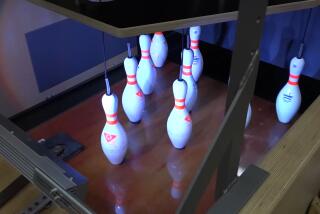Plenty of Balls in the Air
- Share via
SAN DIEGO — At first sight, it seemed like just another math lecture.
The professor came equipped with stacks of transparencies covered with equations; the hall was packed with young computer jocks; the speaker was introduced as someone who “needs no introduction”--well-known as a member of the National Academy of Sciences, former chief scientist at AT&T; Research, professor of mathematics at UC San Diego. What gave the game away was the speaker’s red Jansport backpack. Instead of holding papers, it overflowed with white and yellow balls, spilling out like Easter eggs from a basket.
This could only be Ronald Graham--not just the former president of the American Mathematical Society, but also the former president of the International Jugglers Assn. Not only world-class mathematician, but also sometime performer with Cirque du Soleil.
Graham had come to Qualcomm Communications to talk to employees--mostly programmers--about the common ground between juggling and mathematics, juggling and programming, juggling and life.
For Graham, juggling is a metaphor for just about everything. Juggling, he says, is a matter of finding efficient ways to put patterns together. And juggling balls so that they don’t collide in the air--or so that two balls don’t land in one hand at the same time--is not that different from juggling personal schedules, telephone signals, slots for TV shows, the paths of incoming missiles, or calculations performed by computers.
“Jugglers look for patterns,” explains the tall, 63-year-old Graham, which is basically what mathematicians do. Like programmers, jugglers start with some basic commands (add this, subtract that; throw ball, catch ball). “You try to find ways to put them together in better ways than anyone else has,” Graham says. Both programmers and jugglers strive for control. The jugglers need the balls to go exactly where their hands send them; the programmers need computers to do exactly as they are told.
The problem is, errors are inevitable.
“The trouble with juggling is, the balls go where you throw them,” Graham says. When the fingers make a minuscule mistake, the ball follows, multiplying the error.
It’s the same for programmers. “The program does exactly what you tell it to do,” he said. “There’s no program that understands: ‘You know what I mean.’ ”
This common ground between math and juggling has led to several PhD theses in the math of juggling over the last several years, said Graham. Many jugglers are mathematicians--and vice versa. One critical problem for both concerns this question: Given inevitable unknowables and inconsistencies, just how good can you get? What are the theoretical limits to efficiency? If you can’t precisely calculate the best routing for millions of telephone calls, for example (and you can’t), can you estimate how close you are to some theoretical optimum? It turns out you can, and Graham’s work has been seminal to the understanding of such problems.
At Qualcomm’s headquarters, Graham showed systems analysts how jugglers can use math to figure out the limits to the patterns they create. Which sequences of balls can go up and down without colliding in midair or both landing in one hand at the same time? Given two hands, how many sequences can you invent? To get a visual grasp on the problem, Graham draws a line of numbered dots. Each dot represents one tick of a hypothetical clock. Every time the clock ticks, a ball can go up or down.
Then he connects the dots to create various patterns. For example, the pattern 441 means that on the first throw, a ball goes up and comes down four ticks later; on the second throw, another ball goes up and comes down four ticks later; on the third throw, a ball goes up and comes down one tick later.
When you connect the dots with lines representing the motions of the balls, it’s clear that no two balls land at the same place at the same time. This pattern can be juggled. Graham picks up his balls and shows how.
But three balls is easy. As the ticks and throws turn into a complicated pattern of overlapping waves, it becomes harder to tell what can be juggled, and what cannot.
Are there mathematical tools for simplifying the patterns of balls? Yes, there are.
For example, say you want to know how many balls you need to juggle any sequence of throws and ticks. You don’t need to draw every pattern and keep track of the waves. You simply add the number of ticks in the sequence (say, 4,4,1) and take the average--in this case three. That tells you three balls are needed to juggle the 4,4,1 sequence. What about 5,5,5,1? That takes four balls. And it’s much harder.
Graham demonstrates. He’s not warmed up, and one ball falls to the ground. “That’s called a sudden gust of gravity,” says Graham. (Graham can juggle up to six balls on a good day. The world record is nine.) Soon, Graham’s lecture winds its way into harder, more sophisticated mathematical territory. He translates the dots and waves into equations; some of these approaches have led to unexpected connections between juggling and a branch of mathematics called number theory.
Often, he stops to poke gentle fun at mathematicians themselves--for example, the way they start a thought with the invitation, “Consider . . . “
“They never tell you why you should consider it,” says Graham. Dealing with really complicated juggling patterns requires computer simulations. Graham starts up a program that does just that. Projected life-size on the auditorium screen, an animated stick-figure juggles anything tossed to it--handling with ease patterns far beyond the reach of human minds and hands.
Just for fun, Graham uses his animated sidekick to demonstrate that anything can be juggled--even words. He translates “ticks” into letters of the alphabet. (That is, 1 tick equals the letter A; 2 equals B; C equals 3--and so forth.) Then he has his computerized companion juggle the word “theorem.” Dozens of balls, it seems, cascade through the virtual air. Then he has it juggle “proof.” The pattern is even more convoluted.
“It just reinforces the fact that proofs are harder than theorems,” Graham jokes dryly.
*
For his grand finale, Graham attempts the notorious 345 sequences--respected among jugglers for their difficulty. Suddenly balls are flying to all different heights, sometimes crossing in the air, rising and falling in complex, syncopated rhythms. All the while, he talks to himself, trying to keep the patterns straight. “There’s a nice saying,” he says. “I’d give my right arm to be ambidextrous.” After the lecture, he gives some young programmers tips on how to flip coins so that heads (or tails) comes up every time. Flipping coins is really a form of juggling, he explains. If you precisely control the throw, you can keep the coin from flipping at all. If it starts off heads up, it stays that way. Even though it appears to flip wildly, it spins but it never flips.
Showmanship is also important, he points out. “It’s important to look awkward. Don’t win every time.”
Later, he drives home to his appropriately round house in La Jolla in a Toyota with license plates that spell out NUMBER. Already home at the round kitchen counter is his wife, Fan Chung.
Chung doesn’t juggle, but she is a prominent mathematician in her own right, and Graham and Chung have published more than 50 papers together, as well as several books. Chung shows off Graham’s bare, spare “juggling room,” where he also practices his one-armed swiveling handstand. (Graham is also an accomplished trampoline artist.) In one of the sitting rooms is a spherical chess set.
Among their many other activities, Graham and Chung mentor dozens of young mathematicians and oversee papers and unfinished mathematics left by the late genius Paul Erdos. The couple provided a semi-permanent “home” for the peripatetic mathematician until his death two years ago.
All of these diverse activities, needless to say, involve a great deal of juggling. Which reminds Graham of yet another reason why juggling is a lot like life.
“Too many balls,” he says. “Not enough hands.”
(BEGIN TEXT OF INFOBOX / INFOGRAPHIC)
Keeping It All in Motion
The mathematics of keeping balls in the air helps computer programmers as well as jugglers to move bits (or balls) around efficiently. By translating “moves” into graphic patterns, mathematicians can see what combinations work--and which don’t. Each line represents the motion of a ball. The number below the dot specifies how many “ticks” the ball stays in the air before coming down again.


